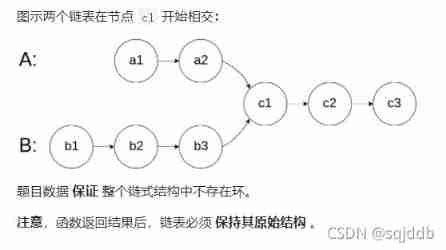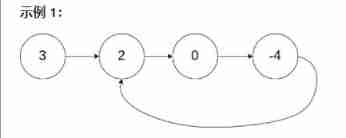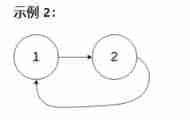当前位置:网站首页>Linked list operation can never change without its roots
Linked list operation can never change without its roots
2022-07-04 10:25:00 【sqjddb】
List operation , All change is the same
- 1. Basic introduction to linked list
- 2. Headless one-way acyclic linked list
- 3. Take the lead in two-way circular list
- 4. Linked list classic topic analysis
- ① Remove linked list elements
- ② Reverse a linked list
- ③ The middle node of a list
- ④ Last in the list k Nodes
- ⑤ Integrate two ordered linked lists
- ⑥ Sort some nodes of the linked list
- ⑦ Palindrome structure of linked list
- ⑧ Public node of linked list
- ⑨ Linked list
- ⑩ Each node contains a linked list of random pointers
1. Basic introduction to linked list
A list is a kind of The physical storage structure is discontinuous 、 Out of order Storage structure , Data elements Logical order It is through... In the linked list Pointer link Sequential implementation of . In practice, the structure of linked list is very diverse , In practice, two structures are most commonly used :
- Headless unidirectional acyclic list : Simple structure , Generally, it is not used to store data alone . In fact, it is more as a substructure of other data structures , Such as hash bucket 、 Adjacency table of graph and so on .
- Take the lead in two-way circular list : The most complex structure , It's usually used to store data separately . Although the structure is complex , But there are many advantages in operation .
2. Headless one-way acyclic linked list
This is a commonly used linked list ,oj Often used in questions , Interview is also commonly used
Realize the complete program of linked list
3. Take the lead in two-way circular list

The advantage of taking the lead in two-way circular linked list is reflected in its basic operation :
Realize a leading two-way circular linked list with functions of addition, deletion and modification
4. Linked list classic topic analysis
① Remove linked list elements
Give you a list of the head node head And an integer val , Please delete all the contents in the linked list Node.val == val The node of , And back to New head node .
Answer and analysis
② Reverse a linked list
Here's the head node of the list head , Please reverse the list , And return the inverted linked list
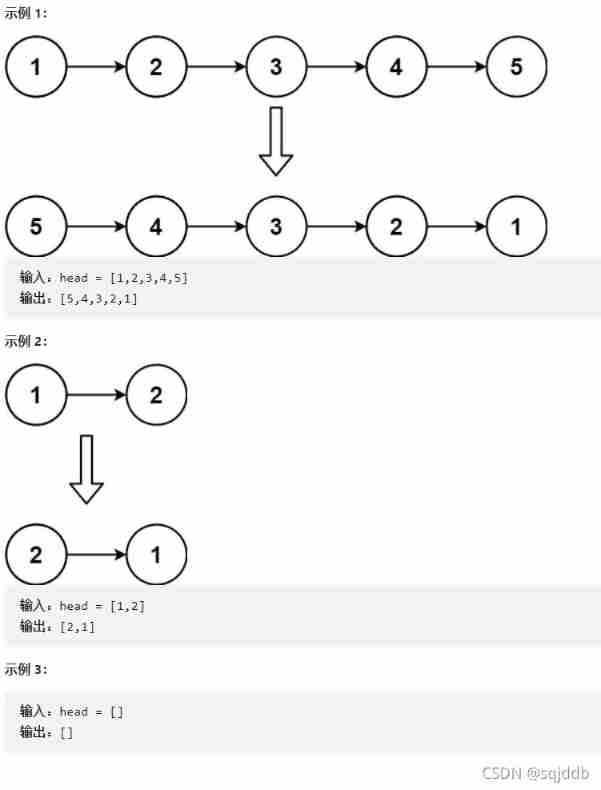
Method 1 :
Define three pointers n1 n2 n3,n1 Record the last node location ,n2 Is the current location ,n3 Is the next node location , When modifying, the current position points to the previous position , then n1,n2,n3 All backward . Pictured :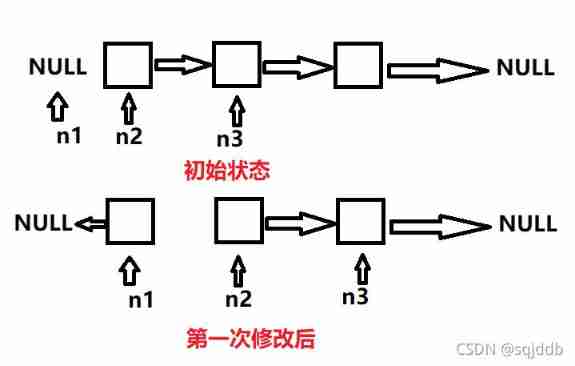
The procedure is as follows :
struct ListNode* reverseList(struct ListNode* head){
if (!head)
return head;
struct ListNode* n1 =NULL;// Record the last node location
struct ListNode* n2 = head;// The current position
struct ListNode* n3 = head->next;// Record the next position
while (n2)
{
n2->next=n1;
n1=n2;
n2=n3;
if(n3)
n3=n3->next;
}
return n1;
}
Method 2 :
Traverse the nodes and insert them in turn , Make the initial tail node into a new head node
struct ListNode* reverseList(struct ListNode* head){
struct ListNode* newhead=NULL;
struct ListNode* cur=head;
while(cur)
{
struct ListNode* next=cur->next;
cur->next=newhead;
newhead=cur;
cur=next;
}
return newhead;
}
③ The middle node of a list
Given a header node as head The non empty single chain table of , Returns the middle node of the linked list .
If there are two intermediate nodes , Then return to the second intermediate node .
Ideas : Fast and slow pointer method , Slow pointer one step , Let's go two steps .
struct ListNode* middleNode(struct ListNode* head){
struct ListNode* fast=head;
struct ListNode* low=head;
while(fast&&fast->next)
{
low=low->next;
fast=fast->next->next;
}
return low;
}
④ Last in the list k Nodes
Topic link 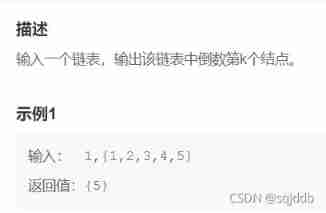
Ideas :
The fast and slow pointer method is more convenient , Let's go first k Step , Then the hands go fast and slow at the same time , Pay attention to special circumstances .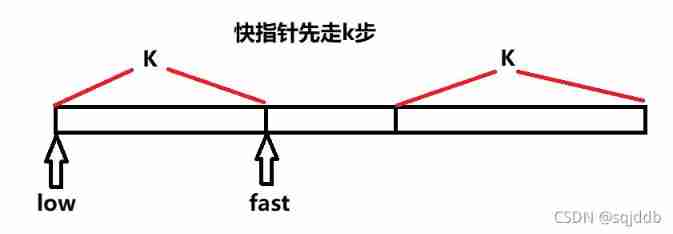
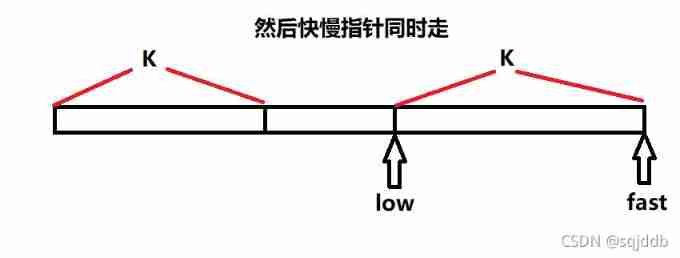
The procedure is as follows :
struct ListNode* FindKthToTail(struct ListNode* pListHead, int k ) {
if(!pListHead)
return NULL;
struct ListNode* low=pListHead;
struct ListNode* fast=pListHead;
while(k--)
{
if(fast==NULL)
return NULL;
fast=fast->next;
}
while(fast)
{
low=low->next;
fast=fast->next;
}
return low;
}
⑤ Integrate two ordered linked lists
Ideas : Create new header , Compare the current node values of the two linked lists , Small ones are inserted at the end of the new linked list , Connect all the rest
The procedure is as follows :
struct ListNode* mergeTwoLists(struct ListNode* l1, struct ListNode* l2){
if(!l1)
return l2;
if(!l2)
return l1;
struct ListNode* newhead=NULL;
struct ListNode* tail=NULL;
struct ListNode* cur1=l1;
struct ListNode* cur2=l2;
if(cur1->val<cur2->val)
{
newhead=l1;
tail=l1;
cur1=cur1->next;
}
else
{
newhead=l2;
tail=l2;
cur2=cur2->next;
}
while(cur1&&cur2)
{
if(cur1->val<cur2->val)
{
tail->next=cur1;
tail=cur1;
cur1=cur1->next;
}
else
{
tail->next=cur2;
tail=cur2;
cur2=cur2->next;
}
}
if(cur1==NULL)
tail->next=cur2;
else
tail->next=cur1;
return newhead;
}
Tips :
The code for creating a new header is a little long , Sure Open up a sentinel node , Then start comparing directly , Finally, return the required pointer , Release sentinel node 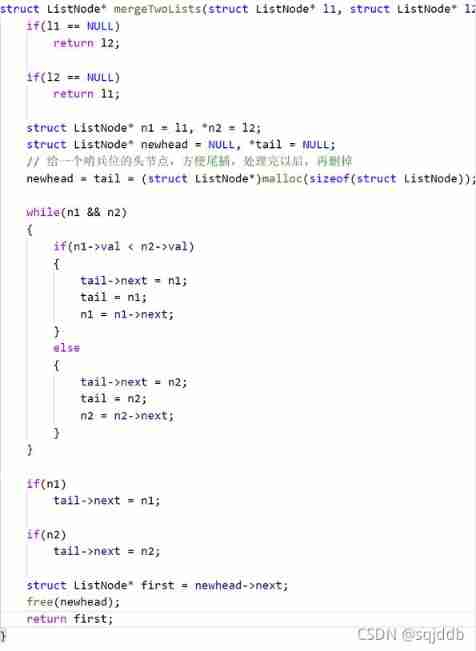
⑥ Sort some nodes of the linked list
The head pointer of an existing linked list ListNode* pHead, Give a certain value x, Write a piece of code that will all be less than x The nodes of are arranged before the other nodes , And the original data order cannot be changed , Returns the head pointer of the rearranged linked list
Ideas : Open up two new heads , Less than x Link together , The rest are linked together , Then the two chains are linked together
The procedure is as follows :
class Partition {
public:
ListNode* partition(ListNode* pHead, int x) {
struct ListNode* lessHead,*lessTail,*greaterHead,*greaterTail;
lessHead=lessTail=(struct ListNode*)malloc(sizeof(struct ListNode));
greaterHead=greaterTail=(struct ListNode*)malloc(sizeof(struct ListNode));
struct ListNode* cur=pHead;
while(cur)
{
if(cur->val<x)
{
lessTail->next=cur;
lessTail=cur;
}
else
{
greaterTail->next=cur;
greaterTail=cur;
}
cur=cur->next;
}
greaterTail->next=NULL;
lessTail->next=greaterHead->next;
struct ListNode* p=lessHead->next;
free(lessHead);
free(greaterHead);
return p;
}
};
⑦ Palindrome structure of linked list
For a linked list , Please design a time complexity of O(n), The extra space complexity is O(1) The algorithm of , Judge whether it is palindrome structure .
Given the head pointer of a linked list A, Please return one bool value , Represents whether it is palindrome structure . Ensure that the length of the linked list is less than or equal to 900.
Ideas : Find the middle node of the list , Reverse the last half of the chain , Traversal comparison .( May refer to ②,③)
class PalindromeList {
public:
// Find the middle node
struct ListNode* middleNode(struct ListNode* head)
{
struct ListNode* fast=head;
struct ListNode* low=head;
while(fast&&fast->next)
{
low=low->next;
fast=fast->next->next;
}
return low;
}
// Reverse order of linked list
struct ListNode* reverseList(struct ListNode* head)
{
struct ListNode* newhead=NULL;
struct ListNode* cur=head;
while(cur)
{
struct ListNode* next=cur->next;
cur->next=newhead;
newhead=cur;
cur=next;
}
return newhead;
}
bool chkPalindrome(ListNode* A)
{
struct ListNode * mid = middleNode(A);
struct ListNode * rhead = reverseList(mid);// The new head after the reverse order is rhead
struct ListNode *head = A;
while(head&&rhead)
{
if(head->val!=rhead->val)
return false;
head=head->next;
rhead=rhead->next;
}
return true;
}
};
⑧ Public node of linked list
Here are two head nodes of the single linked list headA and headB , Please find out and return the starting node where two single linked lists intersect . If there is no intersection between two linked lists , return null
Ideas : First judge whether the linked list intersects , The last node of the intersecting linked list should be the same .
If it intersects , Calculate the length of the two linked lists , Define two pointers to two linked lists , Long list first take two steps of the length difference of the linked list , Then both hands go at the same time , When you go to a position in front of the public node ,next The value of is the same , find .
struct ListNode *getIntersectionNode(struct ListNode *headA, struct ListNode *headB) {
// Determine the length of the two linked lists
struct ListNode * curA = headA;
struct ListNode * curB = headB;
int lenA = 0, lenB = 0;
while(curA)
{
lenA++;
curA=curA->next;
}
while(curB)
{
lenB++;
curB=curB->next;
}
// hypothesis A Longer , If not , In exchange
struct ListNode * longList =headA;
struct ListNode * shortList =headB;
if(lenA<lenB)
{
longList=headB;
shortList=headA;
}
// Long chain takes the first step
int gap = abs(lenA-lenB);
while(gap--)
{
longList = longList->next;
}
// Go at the same time , Judge whether there is intersection
while(longList&&shortList)
{
if(longList == shortList)
{
return longList;
}
shortList = shortList->next;
longList = longList->next;
}
return NULL;
}
⑨ Linked list
a. Determine if the list has links
Given a linked list , Judge whether there are links in the list
Ideas : The speed pointer walks from the beginning at the same time , Slow pointer one step , Let's go two steps , If there are rings , The fast and slow pointers will meet
The procedure is as follows :
bool hasCycle(struct ListNode *head) {
struct ListNode* low=head;
struct ListNode* fast=head;
while(fast&&fast->next)
{
low=low->next;
fast=fast->next->next;
if(low==fast)
{
return true;
}
}
return false;
}
b. Return the ring entry position of the linked list with links
Given a linked list , Return to the first node of the link where the list begins to enter . If the list has no links , Then return to null.
Ideas :
There is a conclusion : use a Method to determine whether the linked list has a ring , If there is , You can find where the fast and slow pointers meet , Make a pointer walk step by step from where it meets , Make the other pointer walk step by step at the same time , They will eventually meet at the entrance
Proof process :
( There are many details worth thinking about in this process )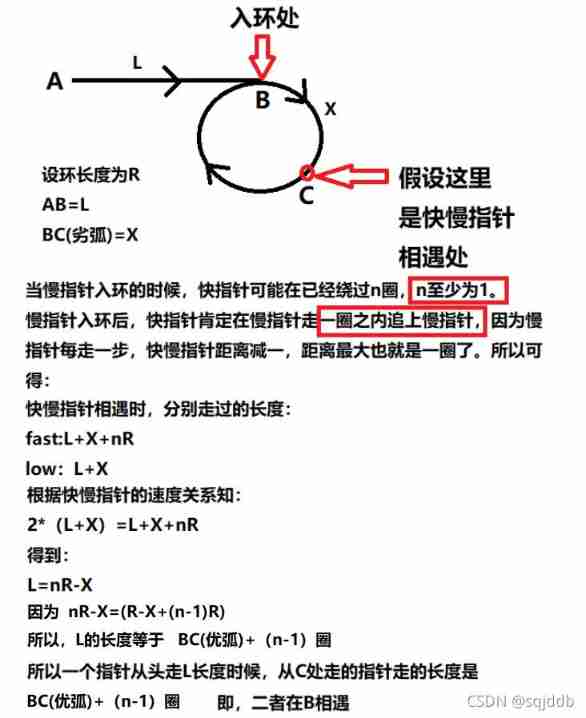
The procedure is as follows :
struct ListNode *detectCycle(struct ListNode *head) {
struct ListNode* low=head;
struct ListNode* fast=head;
while(fast&&fast->next)
{
low=low->next;
fast=fast->next->next;
if(low==fast)
{
struct ListNode* meet=low;
while(meet!=head)
{
head=head->next;
meet=meet->next;
}
return meet;
}
}
return NULL;
}
⑩ Each node contains a linked list of random pointers
Give you a length of n The linked list of , Each node contains an additional random pointer random , The pointer can point to any node or null node in the list .
To construct this linked list Deep copy . The deep copy should be made exactly by n individual new Node composition , The value of each new node is set to the value of its corresponding original node . New nodes next Pointers and random The pointer in the list should also point to the new node , And make these pointers in the original linked list and the copied linked list represent the same linked list state . The pointer in the copy linked list should not point to the node in the original linked list
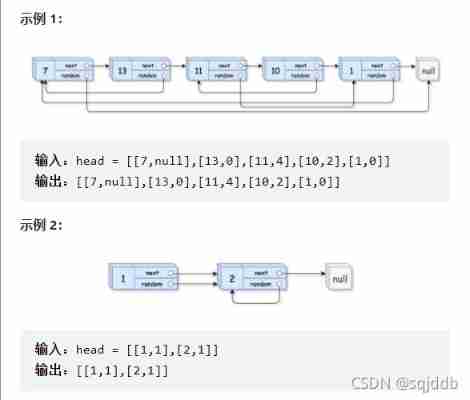
Ideas :
think first of , Traversal replication , But the node pointed to by the random pointer of the current position may not have been created
One method :
Insert a new node after each node , Then assign a value to the random pointer of the new node , Finally, link all the new nodes just inserted and copy successfully .
The basis of random pointer assignment : Each newly inserted node replicates the old node before it , The old node accesses another old node according to the random pointer , The new node is also inserted after the old node accessed , Old node —— Old node and New node —— New nodes The relative distance is the same , The direction of the random pointer is determined .
The procedure is as follows :
struct Node* copyRandomList(struct Node* head) {
if(head==NULL)
return NULL;
// The copy node is behind the original node
struct Node* cur=head;
while(cur)
{
struct Node* next=cur->next;
struct Node* copy=(struct Node*)malloc(sizeof(struct Node));
copy->val=cur->val;
cur->next=copy;
copy->next=next;
cur=next;
}
// Assign values to random nodes
cur=head;
while(cur)
{
struct Node* copy=cur->next;
if(cur->random)
{
copy->random=cur->random->next;
}
else
{
copy->random=NULL;
}
cur=copy->next;
}
// Link the new nodes
struct Node* copyhead,*copytail;
copyhead=copytail=(struct Node*)malloc(sizeof(struct Node));
cur=head;
while(cur)
{
struct Node* copy=cur->next;
struct Node* next=copy->next;
copytail->next=copy;
copytail=copy;
cur->next=next;
cur=next;
}
struct Node* p=copyhead;
copyhead=copyhead->next;
free(p);
return copyhead;
}
边栏推荐
- Work order management system OTRs
- 基于线性函数近似的安全强化学习 Safe RL with Linear Function Approximation 翻译 2
- system design
- 按键精灵打怪学习-识别所在地图、跑图、进入帮派识别NPC
- Hands on deep learning (46) -- attention mechanism
- Legion is a network penetration tool
- 基于线性函数近似的安全强化学习 Safe RL with Linear Function Approximation 翻译 1
- Hands on deep learning (III) -- Torch Operation (sorting out documents in detail)
- SQL replying to comments
- Exercise 9-4 finding books (20 points)
猜你喜欢
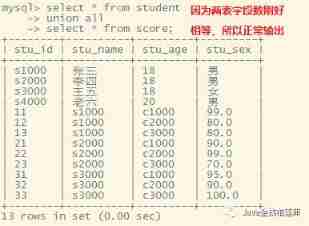
DML statement of MySQL Foundation

Tables in the thesis of latex learning
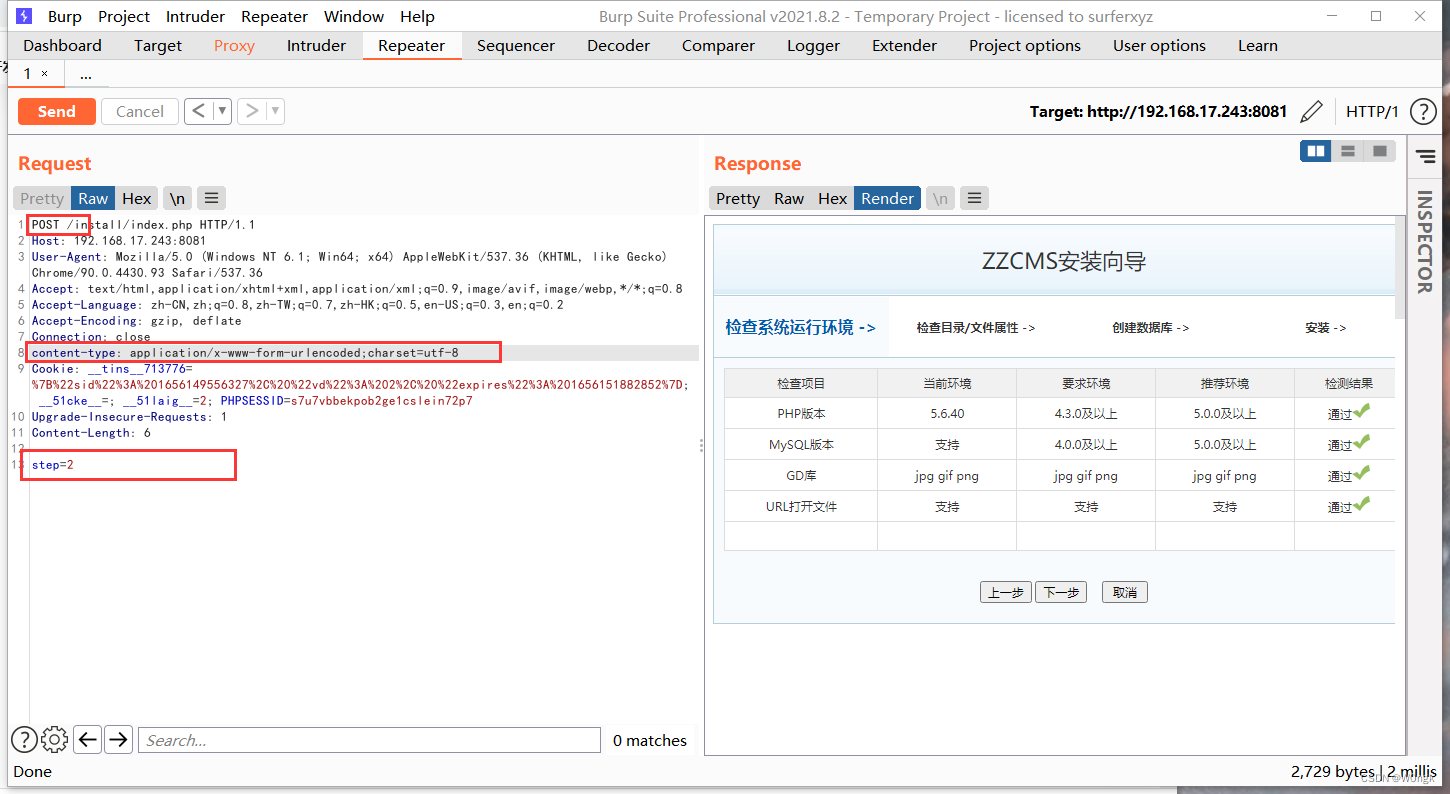
PHP code audit 3 - system reload vulnerability

Latex learning insertion number - list of filled dots, bars, numbers
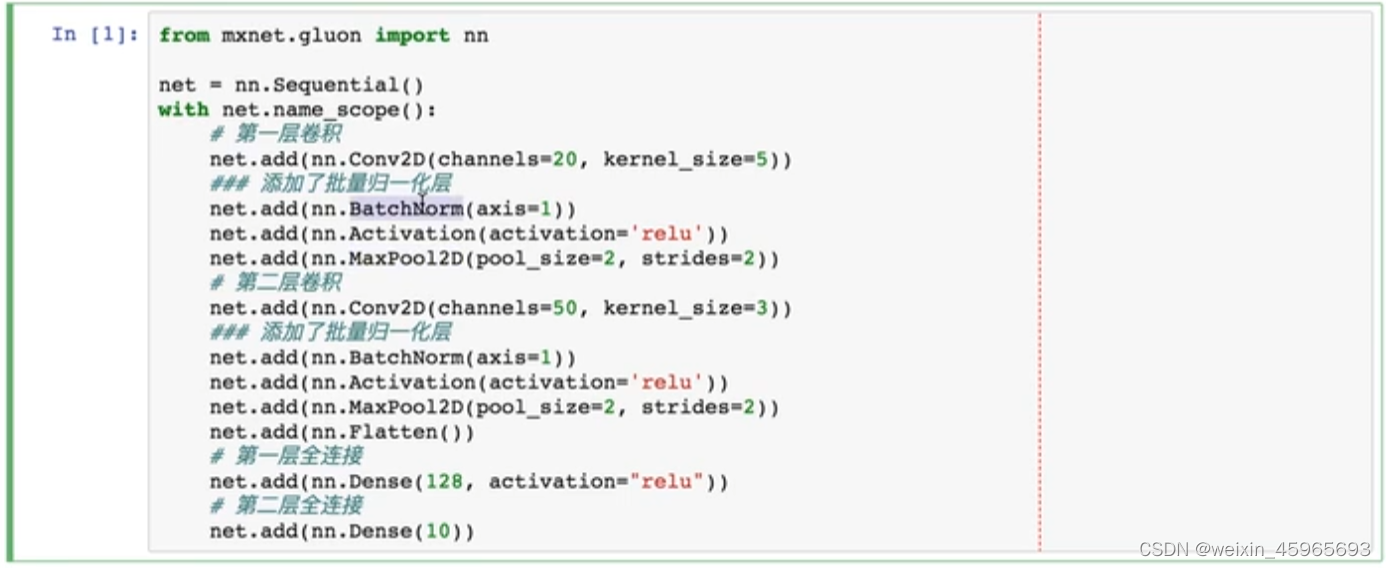
【Day2】 convolutional-neural-networks

Hands on deep learning (40) -- short and long term memory network (LSTM)

Introduction to extensible system architecture
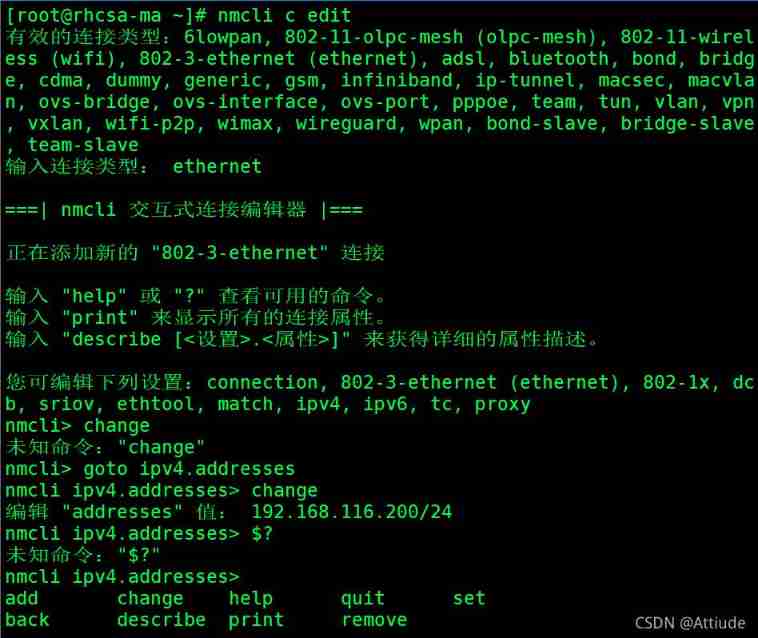
Rhcsa12

5g/4g wireless networking scheme for brand chain stores
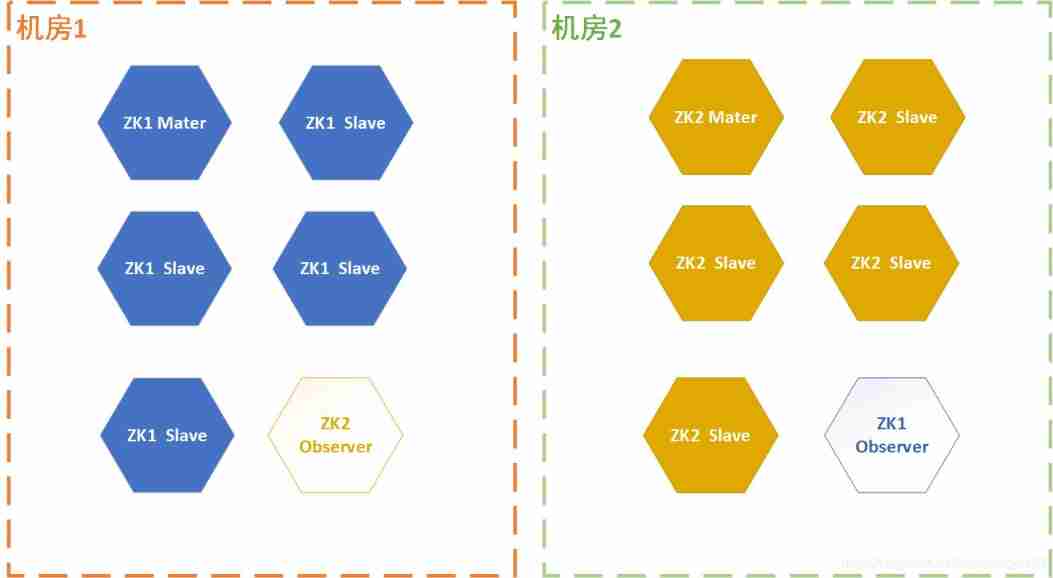
Three schemes of ZK double machine room
随机推荐
Basic principle of servlet and application of common API methods
入职中国平安三周年的一些总结
leetcode1-3
Uniapp--- initial use of websocket (long link implementation)
PHP代码审计3—系统重装漏洞
From programmers to large-scale distributed architects, where are you (2)
How can Huawei online match improve the success rate of player matching
The future education examination system cannot answer questions, and there is no response after clicking on the options, and the answers will not be recorded
Exercise 8-10 output student grades (20 points)
uniapp---初步使用websocket(长链接实现)
【Day1】 deep-learning-basics
Es advanced series - 1 JVM memory allocation
Check 15 developer tools of Alibaba
Safety reinforcement learning based on linear function approximation safe RL with linear function approximation translation 1
六月份阶段性大总结之Doris/Clickhouse/Hudi一网打尽
OSPF comprehensive experiment
Realsense d435 d435i d415 depth camera obtains RGB map, left and right infrared camera map, depth map and IMU data under ROS
System. Currenttimemillis() and system Nanotime (), which is faster? Don't use it wrong!
转载:等比数列的求和公式,及其推导过程
uniapp 处理过去时间对比现在时间的时间差 如刚刚、几分钟前,几小时前,几个月前

